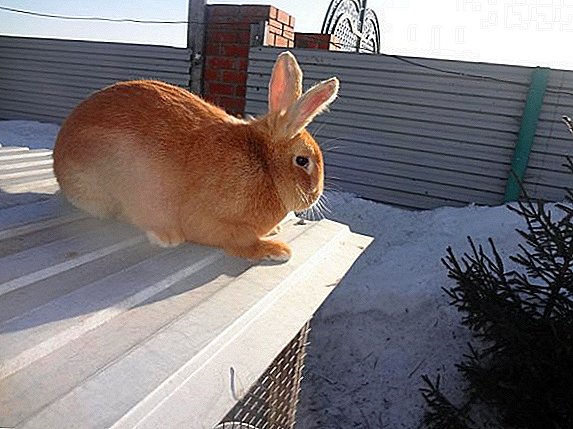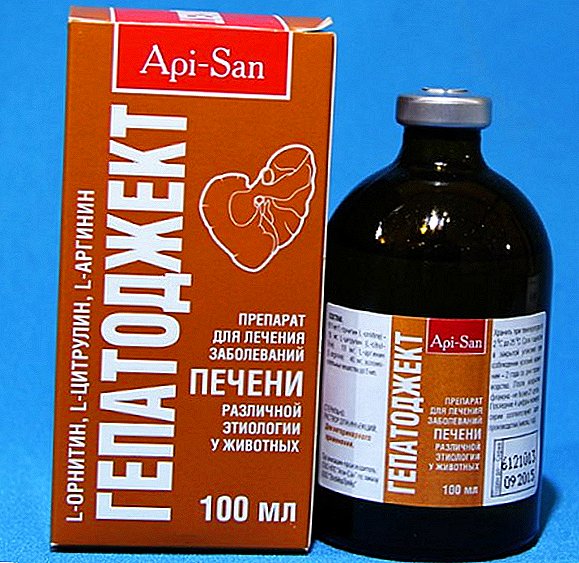 Hepatodject - injection, used in veterinary medicine, has a hepatoprotective effect. The drug is effective in the prevention and treatment of acute and chronic liver diseases of various origins.
Hepatodject - injection, used in veterinary medicine, has a hepatoprotective effect. The drug is effective in the prevention and treatment of acute and chronic liver diseases of various origins.
Composition, release form and packaging
The solution for injection is available in glass bottles of 20 and 100 ml in vials, sealed with a rubber stopper with an aluminum cap.
The composition of Hepatodject includes (indicated in 1 ml): 15 mg - L-ornithine, 10 mg - L-citrulline, 40 mg - L-arginine, 15 mg - betaine, 200 mg - sorbitol, 1 mg - lidocaine hydrochloride, 0 , 5 mg - methylparaben, 0.2 mg - propylparaben, up to 1 ml of water for injection.
Did you know? Many pets do not have wild ancestors. A vivid example is a cow.

Pharmacological properties
Hepatoprotective effect of the drug is due to its constituent components:
- L-ornithine (involved in the formation of urea and ammonia, activates protein metabolism);
- L-citrulline (amino acid, which is involved in the cycle of formation of urea, stimulates metabolism);
- L-Arginine (amino-guanidyl-valeric acid; regulates blood sugar levels, provides a healthy artery tone);
- Betaine (has choleretic action, is involved in the process of metabolic methylation.
Did you know? The imprint of each cat's nose is as individual as the imprint of a human finger.
Indications for use
Hepatodject normalizes the regeneration of liver cells, impaired endo-and ekzotoksikozami, somatic and infectious diseases. In addition, the drug significantly reduces the hepatotoxic effect of drugs. 
Important! Unsystematic administration of the drug, skipping one or more doses may cause a decrease in the therapeutic efficacy of Hepatodject. If the dose is still missed, the dose should be resumed with the same dosage, following the scheme prescribed by the veterinarian.
Dosing and Administration
The solution is injected slowly intravenously or deeply intramuscularly. A single dose is individual for each type of animal. The full course of treatment is designed for 5-7 days. If the condition of the animal does not improve, the treating veterinarian may decide to extend the course of treatment to two weeks.
Cattle
The single dose for adult cattle is 50-100 ml. For calves (animals up to six months), this dose is calculated depending on body weight: 1 ml of solution for 5-10 kg of animal body weight.
Learn more about such breeds of cows as "Highland", "Red Steppe", "Ayrshirskaya", "Jersey", "Brown Latvian", "Yaroslavskaya", "Aberdeen-Angus", "Kalmyk", "Kakhakhskaya White-headed", " Kholmogorskaya, Simmentalskaya and Golshtinskaya.

Sheep and Pigs
A single dose for adult pigs and sheep is 10-15 ml. In the case of Hepatodject for treating piglets or lambs, it is necessary to inject at most 3-5 ml of solution at a time.
Learn all about the breeding of such breeds of pigs as landrace, karmala pigs, Pietrain, Hungarian downy mangalitsa, Vietnamese, Duroc, Mirgorod, red-belt.
Horses
A single dose of the solution, which is used to treat horses, is 50-100 ml. Applying Hepatodject for foals, you should count 1 ml of solution for 5-10 kg of body weight.
Dogs and cats
Following the instructions for the use of Hepatodject for cats, to achieve the desired therapeutic effect, you should enter no more than 2-5 ml at a time. Pregnant cats, as well as feeding offspring, the use of the drug is allowed only under the supervision of a specialist.
An identical dose of the drug is recommended by the instruction and for the treatment of dogs. Hepatoject cats and dogs should be injected into a vein, or, as deeply as possible, subcutaneously or intramuscularly. 
Precautions and special instructions
Meat and milk of animals, which the drug was introduced less than a day ago, is strictly prohibited to eat. At the same time, these animal products are completely harmless as animal feed.
You will probably be interested to get acquainted with the method of determining the body weight of an animal without scales.People with hypersensitivity to any of the components of the drug should avoid direct contact with the solution.
Hepatodeject is a fairly strong and effective drug, therefore it is not recommended to give it to animals independently. Before you prick Hepatodject to a cat, dog, or farm animal, you should always consult a veterinarian.
Contraindications and side effects
Important! The drug belongs to non-hazardous substances and does not have an embryonic toxic effect, provided it is used in therapeutic doses.
 The drug usually has no side effects. In animals with hypersensitivity to the components of the drug, allergies may develop. In this case, the use of the drug should be discontinued. To alleviate the condition of the animal, it requires symptomatic treatment and antihistamine therapy.
The drug usually has no side effects. In animals with hypersensitivity to the components of the drug, allergies may develop. In this case, the use of the drug should be discontinued. To alleviate the condition of the animal, it requires symptomatic treatment and antihistamine therapy.Shelf life and storage conditions
The product must be kept out of the reach of children and animals. Avoid direct sunlight and high humidity; optimum temperature - from 5 ° C to 25 ° C. The tool must not be stored together with food and in places accessible to children.
Shelf life of an open bottle - 3 weeks. The contents of the closed vial are usable for two years from the date of manufacture. After the expiration date, use of the drug is prohibited.
In Hepatoject, there are two directions: prevention of the disease and its treatment. Taking prophylactic hepatodojects can protect the liver from various diseases. For animals in which this organ already works with impairments, Hepathoject is an effective medication that allows normalizing its basic functions.












